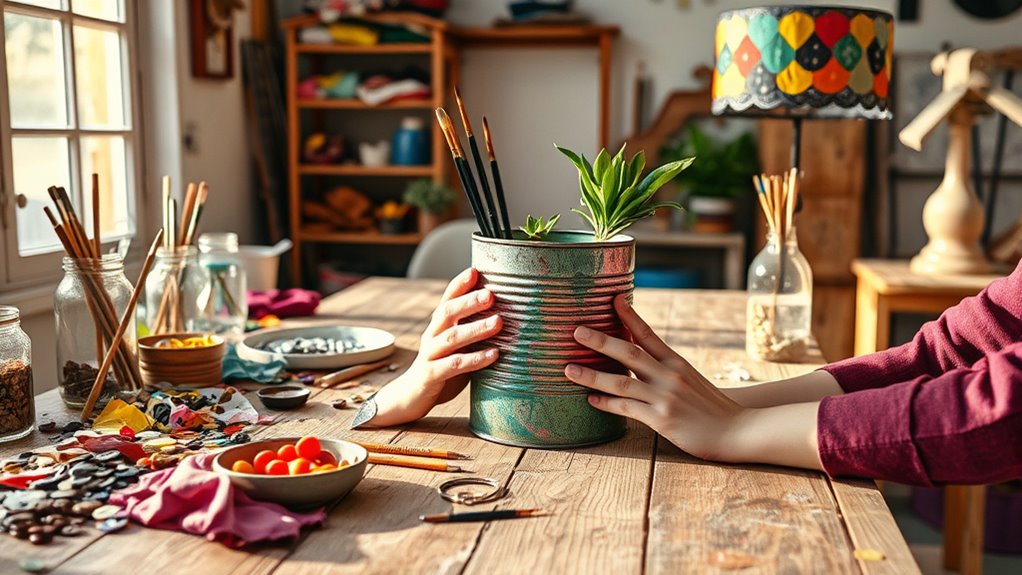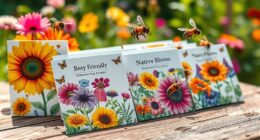DIY and upcycling are great ways to reuse everyday items and reduce waste. You can turn old clothes into stylish accessories, repurpose jars and bottles as plant containers, or create furniture from recycled pallets. These projects are cost-effective, fun, and eco-friendly, helping you make a positive impact on the environment. By exploring creative ideas and simple tools, you’ll discover countless ways to give new life to items you might otherwise toss away. Want to see some inspiring examples?
Key Takeaways
- Upcycling transforms old items into new, useful objects, reducing waste and promoting sustainability.
- Creative DIY projects like turning T-shirts into tote bags or bottles into lanterns encourage reuse.
- Using recycled containers and materials in gardening enhances aesthetics while minimizing ecological impact.
- Gathering inspiration and utilizing simple tools can help start innovative upcycling projects at home.
- Upcycling offers cost-effective, eco-friendly solutions that foster creativity and environmental responsibility.

Have you ever wondered how you can turn old, unused items into something new and useful? Upcycling is a fantastic way to breathe new life into things that might otherwise be thrown away. Not only does it help reduce waste, but it also sparks your creativity. For example, recycled fashion allows you to transform worn-out clothes or fabric scraps into stylish, unique pieces. You might turn an old T-shirt into a tote bag or repurpose fabric from damaged garments into patchwork accessories. This approach cuts down on fast fashion’s environmental impact and lets you wear something truly one-of-a-kind. Plus, exploring recycled fashion encourages you to think outside the box and appreciate the value of what you already have.
Similarly, sustainable gardening benefits greatly from upcycling. You can use recycled containers like jars, cans, or plastic bottles as plant pots, giving them a new purpose while reducing plastic waste. Old pallets make excellent garden furniture or compost bins, and leftover materials such as broken tiles or bricks can create charming pathways. When you embrace sustainable gardening through upcycling, you not only minimize your ecological footprint but also enjoy the satisfaction of creating a lush, eco-friendly space. It’s a practical way to incorporate reuse into your daily life, and it can be surprisingly easy and cost-effective.
Getting started with upcycling doesn’t need to be complicated. Begin by gathering items you no longer need—clothes, jars, furniture, or scrap materials—and brainstorm how they might be transformed. You can find inspiration online, in magazines, or through local craft workshops. Simple tools and a little creativity are all you need. For instance, turning an old ladder into a plant stand or converting wine bottles into decorative lanterns can add charm to your home or garden. With a little effort, you’ll find that many everyday objects have potential beyond their original purpose. Plus, each project reduces waste and supports a more sustainable lifestyle.
Frequently Asked Questions
How Can I Start With Simple Upcycling Projects at Home?
To start with simple upcycling projects at home, begin by exploring basic recycling techniques like repurposing jars or old furniture. Look around for items you no longer use and think creatively about transforming them into functional, decorative pieces. For example, turn jars into storage containers or use wooden pallets for creative storage solutions. These small projects boost your sustainability and add a personal touch to your space effortlessly.
What Are the Best Eco-Friendly Materials for DIY Crafts?
You should choose eco-friendly materials like recycled plastics and natural fibers for your projects. Recycled plastics, such as bottles or containers, are versatile and reduce waste, while natural fibers like cotton, jute, or hemp are biodegradable and sustainable. These materials not only help protect the environment but also add a unique touch to your crafts. By opting for them, you’re making a positive impact and creating beautiful, eco-conscious items at home.
How Do I Ensure Safety When Working With Recycled Materials?
A stitch in time saves nine, so always prioritize safety. When working with recycled materials, handle them carefully and inspect for sharp edges or contaminants. Wear protective gear like gloves, goggles, and masks to prevent injuries or inhalation of dust. Proper material handling guarantees you avoid accidents and health risks. Remember, safety isn’t just a precaution; it’s an essential step to enjoy your creative process worry-free.
Can Upcycling Increase the Value of My Home Decor?
Upcycling can definitely boost your home value by enhancing your decor. When you transform old items into stylish decor pieces, you create a unique, personalized space that appeals to potential buyers. This decor enhancement shows creativity and sustainability, making your home more attractive. Incorporating upcycled elements can set your home apart, increasing its charm and worth. So, yes, upcycling not only reduces waste but can also add significant value to your home.
Are There Community Programs That Support DIY and Upcycling Initiatives?
You’re interested in community programs supporting DIY and upcycling initiatives. You can find community workshops that teach you creative reuse skills, participate in local recycling initiatives that promote sustainable waste management, and join neighborhood groups focused on upcycling projects. These programs encourage hands-on learning, foster community connections, and help you reduce waste effectively. By engaging in these activities, you turn waste into art, save money, and contribute to a greener environment.
Conclusion
By embracing DIY and upcycling, you transform waste into treasures, turning clutter into a canvas of creativity. Think of each project as planting seeds of sustainability that grow into a greener tomorrow. Every item you repurpose is a small victory in reducing waste and making a positive impact. So go ahead, pick up that old jar or worn-out shirt—your hands hold the power to craft a better, more beautiful world, one creative step at a time.










